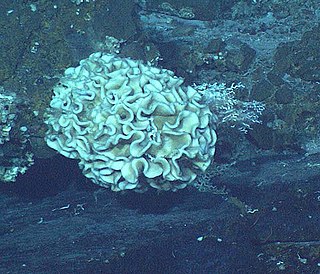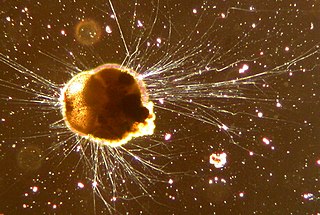Related Research Articles
The Carboniferous is a geologic period and system that spans 60 million years from the end of the Devonian Period 358.9 million years ago (Mya), to the beginning of the Permian Period, 298.9 Mya. The name Carboniferous means "coal-bearing" and derives from the Latin words carbō ("coal") and ferō, and was coined by geologists William Conybeare and William Phillips in 1822.
The Mississippian is a subperiod in the geologic timescale or a subsystem of the geologic record. It is the earlier/lower of two subperiods of the Carboniferous period lasting from roughly 358.9 to 323.2 million years ago. As with most other geochronologic units, the rock beds that define the Mississippian are well identified, but the exact start and end dates are uncertain by a few million years. The Mississippian is so named because rocks with this age are exposed in the Mississippi Valley.

The Paleogene is a geologic period and system that spans 43 million years from the end of the Cretaceous Period 66 million years ago (Mya) to the beginning of the Neogene Period 23.03 Mya. It is the beginning of the Cenozoic Era of the present Phanerozoic Eon. The earlier term Tertiary Period was used to define the span of time now covered by the Paleogene and subsequent Neogene periods; despite no longer being recognised as a formal stratigraphic term, 'Tertiary' is still widely found in earth science literature and remains in informal use. The Paleogene is most notable for being the time during which mammals diversified from relatively small, simple forms into a large group of diverse animals in the wake of the Cretaceous–Paleogene extinction event that ended the preceding Cretaceous Period. The United States Geological Survey uses the abbreviation PE for the Paleogene, but the more commonly used abbreviation is PG with the PE being used for Paleocene.

Xenophyophorea is a clade of foraminiferans. Members of this class are multinucleate unicellular organisms found on the ocean floor throughout the world's oceans, at depths of 500 to 10,600 metres. They are a kind of foraminiferan that extracts minerals from their surroundings and uses them to form an exoskeleton known as a test.

Foraminifera are single-celled organisms, members of a phylum or class of amoeboid protists characterized by streaming granular ectoplasm for catching food and other uses; and commonly an external shell of diverse forms and materials. Tests of chitin are believed to be the most primitive type. Most foraminifera are marine, the majority of which live on or within the seafloor sediment, while a smaller number float in the water column at various depths. Fewer are known from freshwater or brackish conditions, and some very few (nonaquatic) soil species have been identified through molecular analysis of small subunit ribosomal DNA.

The Rhizaria are a species-rich supergroup of mostly unicellular eukaryotes. Except from the Chlorarachniophyte and three species in the genus Paulinella in the phylum Cercozoa, they are all non-photosynthethic, but many foraminifera and radiolaria have a symbiotic relationship with unicellular algae. A multicellular form, Guttulinopsis vulgaris, a cellular slime mold, has also been described. This supergroup was proposed by Cavalier-Smith in 2002. Being described mainly from rDNA sequences, they vary considerably in form, having no clear morphological distinctive characters (synapomorphies), but for the most part they are amoeboids with filose, reticulose, or microtubule-supported pseudopods. Many produce shells or skeletons, which may be quite complex in structure, and these make up the vast majority of protozoan fossils. Nearly all have mitochondria with tubular cristae.
The Maastrichtian is, in the ICS geologic timescale, the latest age of the Late Cretaceous epoch or Upper Cretaceous series, the Cretaceous period or system, and of the Mesozoic era or erathem. It spanned the interval from 72.1 to 66 million years ago. The Maastrichtian was preceded by the Campanian and succeeded by the Danian.
Calabrian is a subdivision of the Pleistocene Epoch of the geologic time scale, defined as ~1.8 Ma.—781,000 years ago ± 5,000 years, a period of ~1.019 million years .

The Allogromiida is an order of single-chambered, mostly organic-walled foraminiferans, including some that produce agglutinated tests (Lagynacea). Genetic studies indicate that some foraminiferans with agglutinated tests, previously included in the Textulariida or as their own order Astrorhizida, may also belong here. Allogromiids produce relatively simple tests, usually with a single chamber, similar to those of other protists such as Gromia. They are found as both marine and freshwater forms, and are the oldest forms known from the fossil record.

The Fusulinida is an extinct order within the Foraminifera in which the tests are composed of secreted hyaline calcite. Like all forams, they were single-celled organisms. In advanced forms the test wall was differentiated into two or more layers. Loeblich and Tappan, 1988, gives a range from the Lower Silurian to the Upper Permian, with the fusulinid foraminifera going extinct with the Permian–Triassic extinction event. While the latter is true, a more supported projected timespan is from the Mid-Carboniferous period.
The Cenomanian is, in the ICS' geological timescale, the oldest or earliest age of the Late Cretaceous epoch or the lowest stage of the Upper Cretaceous series. An age is a unit of geochronology; it is a unit of time; the stage is a unit in the stratigraphic column deposited during the corresponding age. Both age and stage bear the same name.

The Turonian is, in the ICS' geologic timescale, the second age in the Late Cretaceous epoch, or a stage in the Upper Cretaceous series. It spans the time between 93.9 ± 0.8 Ma and 89.8 ± 1 Ma. The Turonian is preceded by the Cenomanian stage and underlies the Coniacian stage.
The Paleocene, or Palaeocene, is a geological epoch that lasted from about 66 to 56 million years ago (mya). It is the first epoch of the Paleogene Period in the modern Cenozoic Era. The name is a combination of the Ancient Greek palæo- meaning "old" and the Eocene Epoch, translating to "the old part of the Eocene".
Carterina is a genus in the Carterinida. The type species is Carterina spiculotesta Brady, 1884. The genus is described from specimens gathered during the Challenger expedition's circumnavigation of the Earth from 1872-1876.

The 2020 UEFA European Football Championship, commonly referred to as UEFA Euro 2020 or simply Euro 2020, is scheduled to be the 16th UEFA European Championship, the quadrennial international men's football championship of Europe organised by the Union of European Football Associations (UEFA).

Thomas Wayland Vaughan was an American geologist and oceanographer. He worked with the United States Geological Survey and United States National Museum, investigating the geology of the West Indies, Panama Canal Zone, and the eastern coast of North America. In 1924 Vaughan became director of the Scripps Institution of Oceanography and held the post until his retirement in 1936. His research work concentrated on the study of corals and coral reefs, the investigation of larger foraminifera, and oceanography.

Kala Chitta Range is a mountain range in the Attock District of Punjab, Pakistan. Kala- Chitta are Punjabi words meaning Kala the Black and Chitta means the white. The range thrusts eastward across the Potohar plateau towards Rawalpindi.
The Planorbulinacea are a superfamily of rotalliid foraminifera that has been extant since the Early Cretaceous (Berriasian), characterized by trochospiral tests, at least in early stage but which later may become uncoiled. The test wall is of perforate hyaline calcite, commonly optically radial in structure, with crystallographic c-axes perpendicular to the surface. The apertural face may be imperforate; the aperture interiomarginal and extraumbilical-umbilical to nearly equatorial in coiled forms, subterminal in uncoiled forms.
The Textulariacea is a superfamily of Middle Jurassic to Holocene agglutinated benthic textulariid Foraminifera. Tests are trochospiral, triserial, or biserial in early stages; later may be biserial or uniserial. Walls are agglutinated, made of gathered material cemented together and are canaliculate - contain micro-tubular cavities extending between the inner and outer surfaces.
Heterohelicoidea is a superfamily of middle Jurassic to Oligocene planktonic forams characterized by biserial or triserial tests, at least in the early stage, that may be reduced in the later stage but more commonly show chamber proliferation in the later stage. Aperture a low or high arch at the base of the final chamber or terminal in uniserial stage. Heterohelicoidea contains one family, the Heterohelicidae.
References
- Loeblich and Tappan (1988). "Valvuliniae". Foraminiferal genera and their classification.
- "Foraminifera". Archived from the original on 2012-06-16. Retrieved 2012-06-16.